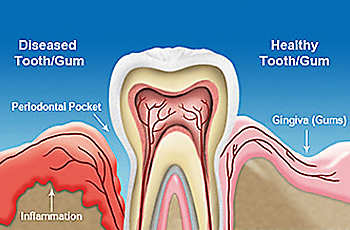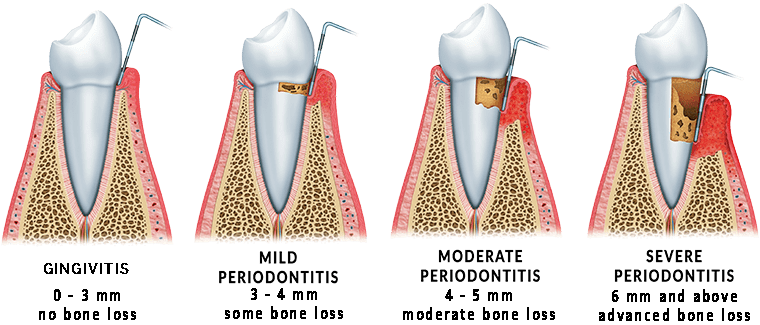About Gum Disease
What is Periodontal Disease?

Gum disease is a problem that happens when your gums get sick and inflamed. It’s caused by bad bacteria that live around your teeth. As the bacteria grow and the gums get worse, the gums can pull away from the teeth and even eat away at the bone that holds the teeth in place. If you don’t take care of gum disease, your teeth can become loose and fall out.
Gum disease is often called a “quiet” disease because it doesn’t usually hurt until it’s really bad. It’s the biggest reason why adults lose their teeth.
Stages of Periodontitis

Periodontitis gets worse over time. Dr. Young checks how bad it is by measuring the space between your gums and teeth with a small tool. He also looks at X-rays to see how much bone you’ve lost.
How Periodontal Disease progresses
Healthy teeth should feel firm and sit snugly in your mouth. Your gums should be pink, tight, and not bleed easily.
Bad bacteria can build up on your teeth and gums from food and other stuff. If you don’t brush and floss well, these bacteria can stick to your teeth and form a sticky film called plaque. Over time, plaque can harden into tartar.
The bacteria in plaque and tartar can make your gums get inflamed and pull away from your teeth. This can also damage the bone around your teeth. As the infection gets worse, your gums might pull away more, your teeth could become loose, and you might even lose them.
Stages of Periodontitis
Moderate
The gum pocket depth has reached 5mm and the gum detachment and bone loss are more severe.
Mild
The gum pocket depth is usually about 4mm. The gums have started to detach from the tooth and there is some bone loss.
Advanced
The pockets around the gums are now really big, more than half a centimeter deep. The gums are pulling away from the teeth, and the jawbone is also shrinking. There are some bad bacteria living in these pockets, and they're getting worse. When the gums pull away and the bone shrinks this much, the tooth might fall out. Sometimes, the tooth gets loose, and that's a sign that there's a problem.
Symptoms of Periodontal Disease
Red/Swollen Gums
Tender/Bleeding Gums
Painful Chewing
Permanent Bad Breath
Receded Gums
Abscess From Gum Line
Teeth Changed Position
Loose Teeth
Gingivitis and Periodontitis
The first level of periodontal disease is known as gingivitis. Gingivitis is a bacterial infection of the gums only (not the bone) and is characterized by inflamed, swollen and red gums that may bleed when you brush or floss. The gums have not started to detach at this stage. This level of infection can usually be eliminated with a thorough professional cleaning and effective home oral care.
The second level of periodontal disease, called periodontitis, is more severe and progresses in stages. At this point the bacterial deposits have not only continued to accumulate, they have started to cause the gums to detach from the teeth and the surrounding bone to be progressively eaten away.
As the gums detach, pockets of space form between the gums and the teeth, allowing more bacteria to be trapped and cause further inflammation. The gum pockets will become progressively deeper as the infection progresses.
Periodontitis accelerates as it grows
As gum pockets become deeper, the types of bacteria that populate these pockets change and are more destructive the deeper the pockets become. This causes the deterioration and bone loss to accelerate in speed and intensity as periodontitis advances
Contributing causes to Periodontal Disease
Smoking
Poor Diet
Poor Oral Hygiene
Irregular Dental Cleanings
Other Health Problems
Other Treatments
Hormonal Changes
Genetic Predisposition
Past Treatments Mistakes
Periodontal Disease links to other health issues
The human body functions as an integrated whole. A diseased condition in one part of your body can affect other parts of your body and cause damage in areas far removed from the original point of trouble.
Numerous studies are showing significant relationships between periodontal disease and serious health conditions to including diabetes, respiratory disease, cardiovascular disease and strokes.


